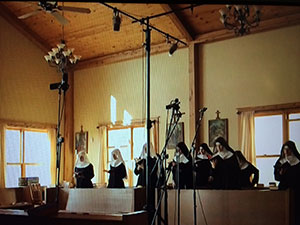 There is a chart-topping music group you may not have heard of – the Benedictine Sisters of Mary, Queen of Apostles. They have recently topped Billboard’s Classical Albums charts with two of their three albums.
There is a chart-topping music group you may not have heard of – the Benedictine Sisters of Mary, Queen of Apostles. They have recently topped Billboard’s Classical Albums charts with two of their three albums.
Why do I mention this? Well, we were watching CBS Sunday Morning on Easter Sunday, and they did a story about the Sisters. One scene showed a recording session with lots and lots of microphones. Of course I immediately exclaimed “hit pause!” to my wife (who controls the DVR remote;)). There were so many mics in so many different positions that I really wanted to study what was going on.
What WAS Going On?
The first thing I thought I recognized was something called a Decca Tree. this is a type of stereo recording set-up developed in the 1950s at Decca Records. It’s a tall pole with a “T” shaped horizontal crossbars at the top which holds three microphones. It was used to best capture orchestras by using a spaced pair (left and right) of mics, combined with a third mic to pick up stuff going on in between. You can see crossbars of the Decca tree at the top of the picture up above. Incidentally, the microphones being used on the tree are Neumann TLM-102 large diaphragm condenser mics (or possibly the TLM-103, which have the same shape). I’re read about the Decca tree configuration before, but I’d never actually seen one. Then I saw what record label had produced and distributed the Sisters’ albums – yup, Decca. Duh.
But that wasn’t the only stereo recording configuration they had! A closer look reveals that there is at least other stereo mic set-up, two instances of the mid-side (m/s) set-up (one for each side, since the nuns were split into two sides of the room). In addition to those three stereo mic clusters (seven microphones so far), there are two spot microphones aimed into the group of nuns agains the far wall in the picture. They are placed high and look to be positioned to capture the room/ambient sound. The spot mics appear to be small-diaphragm condenser mics, such as the Shure SM81.
So with two mid-side groupings and one Decca tree, combined with two room mics, this small choir was recorded with nine microphones! And very high-quality microphones they were. It’s no wonder that the production quality of their last three CDs (they had recorded their own prior to Decca arriving at the door) were so high that they ended up selling so well that they ended up on the Billboard charts. DON’T get me wrong! It’s not ONLY the quality of the production that got them on the charts. A really well-recorded bunch of crappy singers would still be that – polished crap. But the Sisters sing like angels. They will tell you (literally – they did in the interview) that they aren’t great singers. But they practice 5 hours a day. Funny how much difference tons of practice combined with excellent recording technique (from the pro engineers working for Decca) and top-notch gear can make.
Leave a Reply